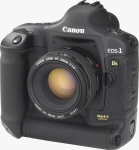 Canon announces EOS-1Ds Mark II
Canon announces EOS-1Ds Mark II
By
Mike Tomkins
(Tuesday, September 21, 2004 - 03:01 EDT)
Imaging heavyweight Canon has today announced a replacement for its EOS-1D single-lens reflex digital camera that will sit alongside the EOS-1D Mark II model announced at the start of the year.
The Canon EOS-1Ds Mark II features a long list of updates as compared to the original EOS-1Ds, many of them incorporating features first seen in the EOS-1D Mark II. As with the original 1Ds, the 1Ds Mark II uses a full-frame (36 x 24mm) image sensor, meaning that where most digital SLRs have a focal length crop / multiplier, this camera won't - lenses will have the exact same focal length as when used on a 35mm film camera. This can be extremely important, depending on your useage - particularly when wide angle photography is necessary. Where the original 1Ds had a CMOS imager with an effective resolution of 11.1 megapixels (8.8 µm pixel size), the 1Ds Mark II 's CMOS sensor will boost this to a class-leading 16.7 effective megapixels (7.2 µm pixel size) - the highest of any currently announced 35mm digital SLR. The sensor incorporates changes first seen on the 1D Mark II - a Canon-developed on-chip RGB primary color filter, larger microlenses that have smaller gaps between them, and a reduction in the number of transistors per pixel (increasing light-sensitive pixel area). The sensor reads eight channels out per line simulatneously, and includes Canon's second-generation, on-chip noise elimination circuit which corrects fixed-pattern and random noise. Impressively (despite the smaller pixel size), the ISO range has been expanded from 50 - 1250 on the older model to 50 - 3200 on the new model (including the expanded settings on both models). This gives the 1Ds Mark II the same ISO range as the 1D Mark II, which again has a larger pixel size of 8.2 µm - yet Canon is predicting "the same low noise" as that model. Where the 1Ds offered just two choices for image size, the 1Ds Mark II will offer four resolutions in JPEG mode - L (16.60MP), M1 (8.60MP), M2 (6.30MP), and S (4.20MP); RAW mode allows only the highest 16.60MP resolution. JPEG files offer a choice of 10 compression levels, and RAW files are now recorded in Canon's .CR2 RAW format, seen previously on the 1D Mark II. Recording quality levels and combinations (JPEG, RAW and RAW + JPEG) can now be accessed directly with the Quality button and the Quick Control Dial. As previously noted, the 1Ds Mark II shares a number of features with the 1D Mark II - among them the same 21-zone metering sensor, 45-point (7 cross-type sensors) autofocus system (although the AI Servo AF algorithm has been optimized for 4 fps operation), E-TTL II flash system, control layout, improved dust- and weather-proofed magnesium alloy chassis, shutter mechanism (rated to 200,000 cycles - 50,000 more than the 1Ds), and storage (CompactFlash Type-I and Type-II including Microdrive, plus Secure Digital - with the ability to use the cards sequentially, or to both cards simultaneously for backup purposes). Speed of the 1Ds Mark II looks to be very satisfactory. Where the 1D Mark II starts up in 0.5 seconds (and the 1Ds in 0.6 seconds), the 1Ds Mark II will be ready to shoot in a speedy 0.3 seconds, all according to Canon's specifications (our own measured times for the 1Ds were somewhat slower). Shutter lag is said to be the same as the 1Ds (55ms, according to Canon - we measured it at 83ms), but as with the 1D Mark II can be reduced to 40ms with maximum aperture set via a Personal Function. Viewfinder blackout is rated at 87ms - the same speeds as the 1D Mark II. Continuous shooting should be four frames per second, for up to 11 RAW frames, or 32 JPEG frames - a whopping increase from the three frames-per-second for 10 frames of the original 1Ds, particularly when you consider the significantly higher resolution. Flash card write speeds are said to be significantly improved (from under 2MB/second in the 1DS to as much as 5.8MB/second on the Mark II, with suitable flash cards), as are FireWire transfer speeds (although we don't have a specific spec for this from Canon). Battery life is also said to be improved, although again no specific detail on the improvement is yet available. A new three-layer optical low-pass filter is said to reduce aliasing artifacts (color moire), in combination with the DIGIC II processor. Overall color reproduction is also said to be improved, while retaining fine color gradations. The histogram function now shows not only the more traditional brightness distribution, but allows the R, G, and B channels to be seen separately - letting you confirm exposure (and clipping) in the individual color channels. The LCD display first seen in the EOS-1D Mark II is used in the 1Ds Mark II, offering almost double the resolution of its predecessor. It also uses a white LED backlight, instead of the 1Ds' fluorescent backlight that used more power, was dimmer, and made judging color more difficult. The pre-set color matrixes - five, in all - have been re-tuned to "control red saturation", according to Canon; as with the 1D Mark II you also have a choice of two user-set matrixes with a choice of Adobe RGB or sRGB, plus 5-step control over saturation and color tone. There are six levels of sharpening available, and three user tone-curves can be uploaded using the supplied software. White balance algorithm improvements first seen in the 1D Mark II have allowed the original 1Ds' external white balance sensor to be removed, meaning that white balance detection is done entirely with the imager - not using a hybrid system. User-set color temperatures now extend as low as 2000K, rather than 2800K on the older 1Ds. As with the 1D Mark II, white balance bracketing now allows three bracketed frames to be captured in a single shot, and the white balance compensation function now offers magenta / green bias as well as the 1Ds' blue / amber bias. Manually adjusted white balance can now be set using the WB button in combination with the Main dial, removing the need to visit the menu system. ISO speed extensions have been moved to the menu screen from the Custom Functions, again likely saving a little time to adjust. Almost all the camera settings displayed on the top and rear LCD panels and in the menus can now be saved to a memory card, allowing them to be shared between multiple cameras (a definite bonus for photographers who have to share a camera in their workplace, or when sending the camera in for servicing!) IPTC information can now be appended to JPEG images, rather than just RAW images - helpful for photojournalists who're more likely to be shooting JPEG thanks to the better upload speed of smaller files anyway. The camera also supports the latest Exif version, Exif v2.21. An Enlarge button has been added to control playback magnification, from 1.5x - 10x in 15 steps. The Erase button has been moved to the bottom row with the Recording Quality and White Balance buttons, and now has a small raised point in its center to distinguish it from the other buttons. A welcome hardware change is the modification to the memory card slot cover release knob, first seen on the 1D Mark II - allowing use of the camera while wearing gloves. Also debuting on the other Mark II camera, and now included on the 1Ds Mark II, is the NTSC / PAL switcheable video output connectivity (allowing photographers to display their images as they're shooting them), along with a USB connection (allowing direct printing of JPEG images to CP Direct, Direct Photo, and PictBridge-compatible printers). The flash hot shoe has been strengthened, which should give a little extra peace of mind. Some changes are perhaps rather less important, but maybe lend a little feeling of quality - such as the Canon logo on the pentaprism now being set in relief, and the "Ds" / "Mark II Digital" nameplates being gold-plated. Two new accessories are being announced alongside the EOS-1Ds Mark II, both also compatible with certain other Canon digital SLR models. The DVK-E2 Data Verification System kit allows confirmation that images have not been modified - as required by some forensic and law enforcement applications. The new WFT-E1A Wireless File Transmitter, which screws onto the bottom of the camera and connects by Firewire, allows the camera to upload images via 802.11b and 802.11g wireless, or wired Ethernet lans - with transfer occurring either immediately, or upon selection after shooting (images can also be uploaded without being written to flash memory, if you prefer). The 1Ds Mark II's software bundle includes Digital Photo Professional 1.5, EOS Viewer Utility 1.2, EOS Capture 1.2, PhotoStitch, TWAIN and WIA drivers. The Canon EOS-1Ds Mark II will be on display at the Canon booth, if you're visiting the Photokina trade show (Cologne, Germany: Sept. 28th) or Photo Plus show (New York Jacob Javits Convention Center: Oct. 21st). The camera body will carry an estimated street price of US$7,999, and the camera is currently scheduled to begin shipping in November 2004. For those of you who crave every last detail, you can find a preview document on the EOS-1Ds Mark II from Canon in a separate news item. | Canon EOS-1Ds Mark II Digital | 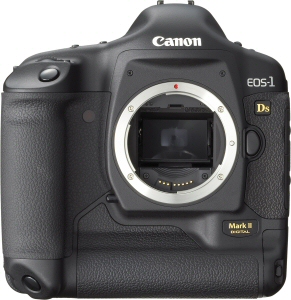 | | Camera Type | | Type: Digital AF/AE SLR | | Recording Medium: Type I or II CF card, SD memory card | | Image Size: 36.0 x 24.0mm | | Compatible Lenses: Canon EF lenses (except EF-S lenses) | | Lens Mount: Canon EF mount | | | Imaging Element | | Type: High-sensitivity, high-resolution, single-plate, color CMOS | | Effective Pixels: Approx. 16.7 megapixels | | Total Pixels: Approx. 17.2 megapixels | | Aspect Ratio: 2:3 (Vertical:Horizontal) | | Color Filter System: RGB primary color filter | | Low-pass Filter: Fixed position in front of the image sensor | | | Recording System | | File Format: Design rule for Camera File system 2.0 (JPEG) and RAW. Exif 2.21 compliant. | | Recording Formats: JPEG and RAW | | File Size (on CF card): JPEG: (1) L (Large): Approx. 5.5MB (4992 x 3328) (2) M1 (Medium1): Approx. 3.2MB (3600 x 2400) (3) M1 (Medium2): Approx. 2.6MB (3072 x 2048) (4) S (Small): Approx. 1.9MB (2946 x 1664) (5) RAW: Approx. 14.6MB (4992 x 3328) JPEG quality: can be set from 1 (min. quality, max. compression) to 10 (max. quality, min. compression). | | Folder Setting: Automatic | | File Numbering: (1) Consecutive numbering (2) Auto reset (3) Manual reset | | Processing Parameters: Standard parameters plus up to three custom processing parameters can be set | | Interface: IEEE1394 for personal computers; USB for direct printing; Video output (NTSC/PAL) | | | White Balance | Settings: Auto, Preset (daylight, shade, overcast, tungsten bulb, fluorescent light, flash), Manual (2800-10000K in 100k increments), Custom (read off photo quality gray card or white subject, color temperature), Personal (up to 3 MB settings can be uploaded to the camera via dedicated software). | | Color Temperature Compensation | White balance bracketing: ±3 stops in full-stop increments White balance correction: ±9 stops in full-stop increments *Blue/amber bias or magenta/green bias possible | | Viewfinder | | Type: Eye-level SLR (with fixed pentaprism) | | Coverage: Approx. 100% vertically and horizontally (Coverage against JPEG Large) | | Magnification: 0.7x (-1 diopter with 50mm lens at infinity) | | Eyepoint: 20mm | | Built-in Dioptric Correction: -3.0 – +1.0 diopter | | Focusing Screen: Interchangeable (9 types), Standard focusing screen: Ec-CIII | | Mirror: Quick-return half mirror (Transmission: reflection ratio of 37:63, no mirror cut-off with EF 1200mm f/5.6 or shorter lens) | | Viewfinder Information: AF information (AF points, focus confirmation light), exposure information (shutter speed, aperture, manual exposure, spot metering circle, ISO speed, exposure level, exposure warning), flash information (flash ready, FP flash, FE lock, flash exposure level), white balance correction, JPEG recording, number of remaining shots, memory card information | | Depth-of-field: Enabled with depth-of-field preview button (with Speedlite 580EX, 550EX, MR-14EX, or MT-24EX, pressing the depth-of-field preview button fires a modeling flash) | | Eyepiece Shutter: Built-in | | | Autofocus | | Type: TTL-AREA-SIR with AF-dedicated CMOS Sensor | | AF Points: 45 | | AF Working Range: EV 0-18 (at ISO 100) | | Focusing Modes: One-Shot AF, Predictive AI Servo AF, AI Focus AF (Automatically selects One-Shot AF or AI Servo AF), Manual focusing (MF) | | AF Point Selection: Automatic selection, manual selection, home position (switch to registered AF point) | | Selected AF Point Display: Superimposed in viewfinder and indicated on LCD panel. | | AF-assist Beam: Emitted by the dedicated Speedlite | | | Exposure Control | | Metering Modes: 21-zone TTL full aperture metering. (1) Evaluative metering (linkable to any AF point), (2) Partial metering (approx. 8.5% of viewfinder at center), (3) Spot metering [Center spot metering (approx. 2.4% of viewfinder at center), AF point-linked spot metering (approx. 2.4% of screen), Multi-spot metering (Max. 8 spot metering entries)], (4) Center-weighted averaged metering | | Metering Range: EV 1-20 (at 20°C with 50mm f/1.4 lens at ISO 100) | | Exposure Control Systems: Program AE (shiftable), Shutter-priority AE, Aperture-priority AE, E-TTL II Autoflash Program AE, and Manual. | | ISO Speed Range: Equivalent to ISO 100-1600 (in 1/3-stop increments), ISO speed can be expanded to ISO 50 and 3200 via menu selection. | | AE Lock: Auto: Operates in One-Shot AF mode evaluative metering when focus is achieved. | | Manual: By AE lock button in all metering modes. | | | Shutter | | Type: Electronically-controlled focal-plane shutter. | | Shutter Speeds: 1/8000 to 30 sec. (1/3-stop increments), bulb, X-sync at 1/250 sec. | | Shutter Release: Soft-touch electromagnetic release | | Noise Reduction: Settable with C.Fn-02 (Noise reduction for long exposures) | | Self-Timer: 10 sec. or 2 sec. Delay. | | Remote Control: Remote control with N3 type terminal. | | | External Speedlite | | EOS External Flash or Dedicated Speedlite: E-TTL II autoflash with EX-series Speedlite. | | PC Terminal: Provided. | | | Drive System | | Drive Modes: Single, Continuous, Self-Timer | | Continuous Shooting Speed: Approx. 4 fps (at 1/250 sec. or faster for all recording quality settings) | | Max. Burst During Continuous Shooting: 32 shots (JPEG Large/Fine)/11 shots (RAW) | | | LCD Monitor | | Type: TFT color LCD monitor | | Monitor Size: 2.0 inches | | Pixels: Approx. 230,000 pixels (displayed pixels) | | Coverage: Approx. 100% (for JPEG images) | | Brightness Adjustment: 5-levels (settable with menu’s “LCD brightness”) | | | Image Playback | | Image Display Format: (1) Single image, (2) Single image with information, (3) 4-image index, (4) 9-image index, (5) Magnified zoom, (6) Manual/automatic rotation | | Highlight Alert: In the single image with information display mode, the highlight portions containing no image information will blink. | | | Image Protection and Erase | | Protection: Erase protection of one image, all images in a folder, or all images in the memory card can be applied or cancelled. | | Erase: One image, all images in a folder, or all images in the memory card can be erased (except protected images). | | | Menus | | Menu Categories: (1) Shooting Menus, (2) Playback Menus, (3) Setup Menus LCD Monitor Language: English, German, Dutch, Danish, Finnish, Italian, Norwegian, Swedish, Spanish, Simplified Chinese and Japanese. | | Firmware Updating: Enabled by the user | | | Power Source | Battery: One Ni-MH Pack NP-E3 | | Number of Shots | | Configuration | | NP-E3 | Normal temp (68°F/20°C) | 1200 frames | | Low temp (32°F/0°C) | 800 frames | | | Dimensions and Weight | | Dimensions (W x H x D): 6.1 x 6.2 x 3.1 in./156 x 157.6 x 79.9mm | | Weight: 42.9 oz./1215g (Body only. battery: 11.8 oz./335g) | | | Working Conditions | | Working Temperature Range: 0-45° C/32-113° F | | Working Humidity: 85% or less | | | More Photos | 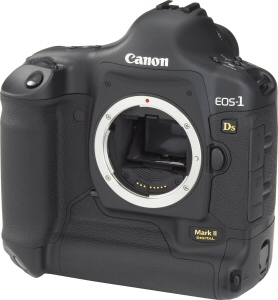 | 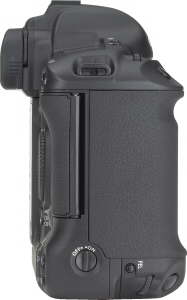 | 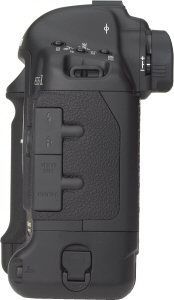 | 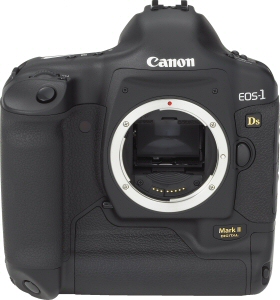 | 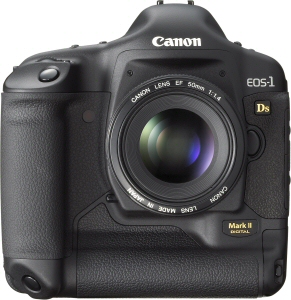 | 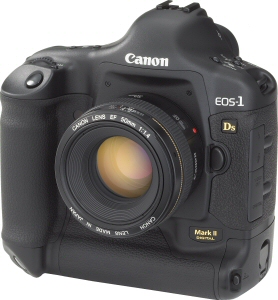 | 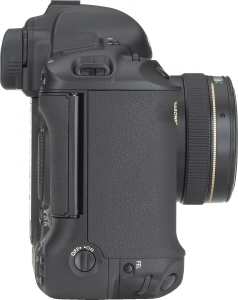 | 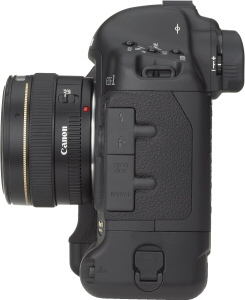 | 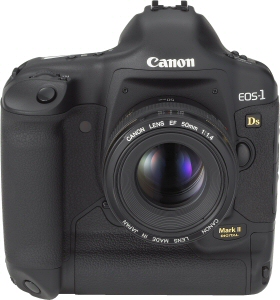 | 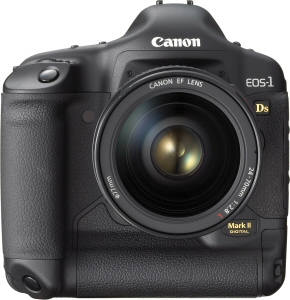 | 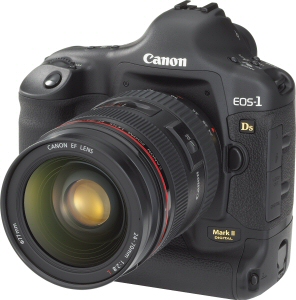 | 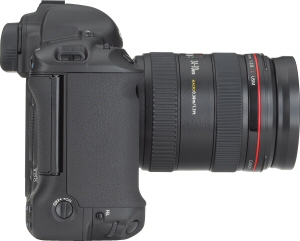 | 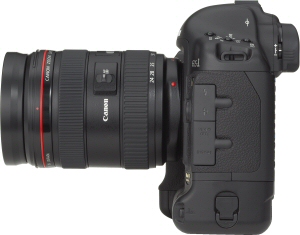 | 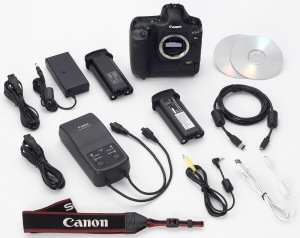 | | . |
|
Original Source Press Release:
| 16.7 MEGAPIXELS OF RIGHTEOUS RESOLUTION: IN THE STUDIO OR ON THE ROAD CANON'S NEW EOS-1Ds MARK II SLR TAKES PRO DIGITAL TO THE NEXT LEVEL OF IMAGING EXCELLENCE With the Highest Resolution, Lowest Noise, Truest Color And Fastest Burst Rate In Its Class, The EOS-1Ds Mark II Digital SLR Is The One Pro Digital Even Medium-Format Film Holdouts Will Love LAKE SUCCESS, N.Y., Sept. 21, 2004 – At long last, catalog and commercial photographers, stock photographers, studio portrait specialists and other professional photographers of every stripe and specialty can capture brilliant high impact images and enjoy the speed, economy, flexibility, increased workflow and productivity that only digital offers, with Canon's new 16.7 megapixel EOS-1Ds Mark II SLR. “The EOS-1Ds Mark II digital SLR camera establishes a new benchmark of innovation and excellence not only for Canon but for our industry as a whole and particularly for the community of professional photographers who are our most demanding and discerning customers,” stated Yukiaki Hashimoto, senior vice president and general manager of the consumer imaging group at Canon U.S.A., Inc., a subsidiary of Canon Inc (NYSE:CAJ). “Up to now, many professional and commercial photographers have been wedded to their medium format film cameras in order to ensure the excellence of their images and the ability to make dramatic enlargements with virtually no reduction in quality. With this remarkable new pro digital SLR, we are sending a message to those medium format fans: your digital dream has been fulfilled.” For those wishing to get a first glimpse of that dream, production models of the new EOS-1Ds Mark II camera will be on display at the Canon booth at the Photokina trade show in Cologne, Germany starting on Sept. 28th and at New York City's Photo Plus show starting on Oct. 21st at the Jacob Javits Convention Center. The EOS-1Ds Mark II camera body carries an estimated street price of $7,999 and is scheduled to begin shipping in November. The successor to Canon's 11.1-megapixel EOS-1Ds SLR introduced in 2002, the new 16.7-megapixel EOS-1Ds Mark II camera utilizes a full-size 24x36mm CMOS sensor that eliminates focal length conversion factors, and features dramatically improved image quality made possible by the combination of new image sensor technology together with Canon's exclusive DIGIC II image processor. The new CMOS sensor features larger microlenses over each photosite compared to the EOS-1Ds resulting in an improved signal-to-noise ratio. On-chip noise reduction has also been improved to produce a cleaner signal before the image data is transferred to the DIGIC II image processor. The DIGIC II processor in turn produces rich, high-chroma color gradations for more naturally rendered images. Indeed, it is the combination of Canon's proprietary CMOS sensor and DIGIC II technology that permits the EOS-1Ds Mark II camera to provide what was once considered near impossible: high definition at high resolution with extremely low levels of false color artifacts. DIGIC II also permits faster processing of large files and is twice as fast as the image processor used in the EOS-1Ds. Color Space…
The EOS-1Ds Mark II camera provides five preset color matrix settings plus two custom settings (as compared with the five presets provided on the original EOS-1Ds camera). In addition, the support for the Adobe RGB color space is improved through the use of DCF 2.0 and Exif 2.21 file formats. …And White Balance
Inherited from the EOS-1D Mark II model is the new camera's white balance correction feature that permits nine +/-adjustments in full step increments; compensation for blue/amber bias or magenta/green bias; white balance bracketing in three +/- full stop increments and auto white balance derived exclusively from image sensor data. The camera features a total of ten white balance settings:Auto, daylight, shade, cloudy, tungsten light, fluorescent light, flash, manual, custom and personal. Fast, Fast, Fast
The EOS-1Ds Mark II pro digital SLR is ready for action just 0.3 seconds after its power switch is clicked on and fires a fast four frames per second at full resolution for bursts of up to 32 JPEG or 11 RAW images (compared with 3 fps for up to 10 frames on the original EOS-1Ds camera). In a commercial studio environment, the EOS-1Ds Mark II camera will actually shoot faster than the time it takes for most studio strobes to recycle. The camera also offers users ISO options from 100 to 1600 in 1/3-stop increments with the flexibility to expand the range to ISO 50 or ISO 3200 by utilizing the camera's custom functions. While the new 1Ds Mark II camera occupies the prestigious flagship position of Canon's professional digital line, it incorporates or surpasses many of the new technological advances introduced earlier this year on the 8.2 megapixel EOS-1D Mark II pro digital SLR, which has become a favorite of photojournalists, sports shooters and wedding photographers. Like its 8.2 megapixel SLR sibling, responsiveness and user-directed adaptability are again clearly evident in the range of the EOS-1Ds Mark II camera's shutter speeds – from 1/8000 to 30 seconds and bulb (with user-set adjustments of 1/3, ½ or full stops). The camera's shutter lag time is just 55ms and focus is achieved in a virtual instant thanks to a 45-point AF system. Precision also extends to the EOS IDs Mark II camera's 21-zone metering sensor, which, as one would expect, works seamlessly with the E-TTL-II flash metering technology. Adding to the camera's versatility and ability to reflect the individuality of the photographer using it, the EOS-1Ds Mark II camera features 20 built-in Custom Functions with 65 settings and 27 personal function settings that can be uploaded to the camera with the use of dedicated software. Recognizing that such customization can be time consuming, all of the camera's settings can now be saved to a memory card and shared with multiple cameras. Should the camera need servicing, the settings can be stored and reloaded after the work is done. With 16.7 effective megapixels (out of a total of 17.2 megapixels) packed on to a 36.0 x 24.0 mm CMOS sensor, the EOS-1Ds Mark II camera offers the world's highest pixel count in a 35mm, full-size digital AF SLR camera. In the JPEG Large and RAW modes, the 4992 x 3328 recorded pixels are easily capable of making 16 x 24 inch enlargements. What's more, the EOS-1Ds Mark II camera has sufficient resolution to generate a full double page spread at 300 DPI, considered the ‘Holy Grail” of catalog photography. Unlike the original 1Ds camera that featured only two image quality settings, the new EOS-1Ds Mark II model places greater control and discretion in the photographer's hands and offers a choice of five image quality settings: RAW (16.6 megapixels); Large JPEG (16.6 megapixels); Medium 1 JPEG (8.6 megapixels), Medium 2 JPEG (6.3 megapixels), and Small JPEG (4.2 megapixels). RAW files and JPEGS can be shot separately or simultaneously, for maximum flexibility according to the desired workflow. E-TTL II Flash Exposure Control
The EOS-1Ds Mark II Pro Digital SLR camera incorporates the E-TTL II Flash control system first introduced on the EOS-1D Mark II model earlier this year. Though it remains compatible with all EX-series Speedlites as well as the E-TTL wireless autoflash system, the smarter E- TTL II flashmetering algorithm evaluates the subject as a “plane “ rather than a simply a point and ensures that images containing various colors and levels of reflection are captured accurately and optimally. The system compares the ambient light with pre-flash data reflected off the subject and recorded by the central 17 metering zones. It then selects the areas with a small difference to be weighted for flash exposure calculation. The system eliminates or under-weights areas with large differences, recognizing them as an extremely reflective object in the background or a highly reflective subject, then smartly ensuring it by considering the distance information data provided from compatible EF lenses. The system similarly prevents over-exposure when photographers lock focus and recompose the shot by considering the flash output level calculated according to the distance. The camera also allows users to select an averaged metering pattern by using its custom function settings. Pick A Card…
Like the 8.2 megapixel EOS-1D Mark II digital SLR that Canon announced in January, this new 16.7 megapixel EOS-1Ds Mark II model is equipped with two dedicated card slots for Compact Flash (Type I or II) and SD memory cards and allows for either simultaneous backup recording for situations where image capture is critical or individual recording on separate cards for capture of an enormous number of images. The EOS-1Ds Mark II camera also features a brilliant and easy to read 230,000 pixel high detail color LCD Monitor (compared with a 120,000 pixel display on the original EOS-1Ds), that measures two inches on the diagonal and provides 100% coverage. Image playback can be automatic after an image has been captured and is also reviewable by simply pressing the “display” button on the rear of the body. The monitor is equipped with a magnification feature that provides a 1.5 X to 10X scrollable zoom in 15 stops, enabling users to check the focus and exposure of their images with a new level of on-the-spot precision. The monitor also provides five brightness settings, a new and bolder typeface to allow for easier reading of text menus and an auto rotation feature that automatically rotates a vertically shot image to enable easier viewing and downloading. Manual clockwise rotation of the image is also possible by 90, 270 or 0 degrees through the image rotation menu. RGB Histogram
Contributing to the precision and control afforded to its users, The EOS-1Ds Mark II camera's RGB histogram display enables separate checking of color and brightness information for the red, green and blue channels. The RGB histogram can also be used to check other color information not available in the brightness display such as white balance bias, color balance, color saturation and the compression of color gradations. Available when viewing any recorded image in the Single (Info.) image playback mode, the RGB histogram is displayed as an alternate to the luminance histogram, which draws attention to overexposed portions of the picture that lack image information. Improved Interface
In addition to the professional-standard four pin IEEE1394 (Firewire) port that enables high speed computer interface at 100 megabits per second, the EOS-1Ds Mark II camera features a new video output terminal which supports TV connection, facilitating the viewing of images on a television screen, as well as a USB port for connection to a computer or Direct Printing with BJ Direct, Canon's Compact Photo Printers and PictBridge compatible printers. Able to stand up to real world conditions – from environmental portraiture, nature, travel or “annual report” type images to high-volume catalog photography, family portrait studios or event imaging applications – this fast and fine thoroughbred SLR is also a rugged, lightweight, weather resistant magnesium alloy workhorse, with a shutter durability-tested to 200,000 exposures (50,000 more than on the original 1Ds camera). The camera's EF lens mount is made of stainless steel and is fully compatible with all Canon EF lenses (except EF-S lenses), as well as TS-E and MP-E lenses. Adding to its allure, the new EOS-1Ds Mark II camera fairly sips power from its battery, executing approximately 1200 shots per charge, double that of its original (and recent) EOS-1Ds ancestor. Bundled Software
The EOS-1Ds Mark II camera is bundled with two software CD-ROMs: the EOS Digital Solution Disk (ver. 9.0) which includes Windows and Macintosh versions of the EOS Viewer Utility (ver. 1.2) which allows image downloading, RAW image adjustment and camera setting specifications; EOS Capture (ver 1.2) and PhotoStitch as well Twain and WIA Drivers (Windows only). The second disk, Digital Photo Professional (ver. 1.5) includes a newly updated RAW image processing application to handle the workflow demands of professional photographers. It enables high-speed RAW image processing and preview, support for sRGB, Adobe RGB and Wide Gamut RGB color spaces and is Color Management System (CMS) compatible. The EOS Capture software supports tethered shooting with Digital Photo Professional as well as EOS Viewer Utility to provide a powerful performance combination for studio photographers. As with the EOS-1D Mark II model, no third party image retouching software is included. Remotely Possible
New for the EOS-1Ds Mark II camera is the optional Wireless File Transmitter (WFT-E1A)**. Given the enormous popularity of LAN-based image transmission systems and the demands for higher speed image distribution in the reporting fields, Canon developed this new accessory that allows photographers to transmit images from their cameras directly to a computer over a wired or wireless local area network (LAN). The WFT-E1 transmitter includes a mini antenna, a long and short IEE1394 cable, a case and camera mounting screw. The transmitter will also be compatible with the EOS-1D Mark II and the EOS 20D digital SLR cameras via a firmware upgrade. Pricing for the WFT-E1 has not been finalized, but will be announced prior to initial dealer shipments in November. Canon U.S.A., Inc. delivers consumer, business-to-business, and industrial imaging solutions. The Company is listed as one of Fortune's Most Admired Companies in America, and is ranked #35 on the latest Business Week list of "Top 100 Brands." Its parent company Canon Inc. (NYSE:CAJ) is a top patent-holder of technology, ranking second overall in the U.S. in 2003, with global revenues of $29.9 billion. For more information, visit www.usa.canon.com. # # # All referenced product names, and other marks, are trademarks of their respective owners. * Prices subject to change at any time. Actual prices are determined by individual dealers and may vary. ** This device has not been authorized as required by the rules of the Federal Communications Commission. This device is not, and may not be, offered for sale or lease, or sold or leased, until authorization is obtained. |
Powered by Coranto
|